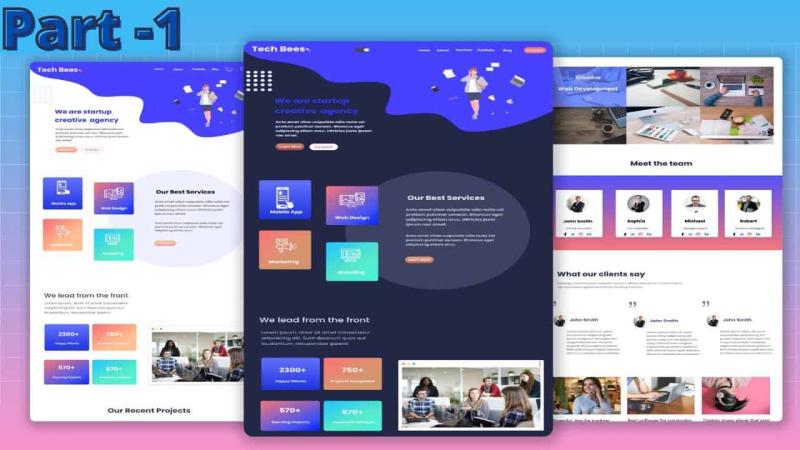How to create a tutorial website?
Creating a tutorial website involves several steps, from planning and content creation to website development and promotion. Here's a step-by-step guide to help you create your own tutorial website:
Step 1: Define Your Niche and Audience
- Choose a Niche: Determine the specific topic or industry for your tutorial website. It could be anything from programming and web development to cooking or language learning.
- Identify Your Target Audience: Understand who your tutorials are intended for. Consider their skill level, interests, and learning preferences.
Step 2: Plan Your Content
- Outline Tutorial Categories: Break down your chosen niche into relevant categories. For example, if your niche is programming, categories could include web development, data science, etc.
- Plan Individual Tutorials: Create a list of specific tutorial topics within each category. Outline the key points and steps for each tutorial.
Step 3: Choose a Platform
- Select a Website Building Platform:
- Content Management System (CMS): Platforms like WordPress, Joomla, or Drupal are user-friendly and offer various themes and plugins.
- Website Builders: Platforms like Wix, Squarespace, or Weebly provide easy drag-and-drop functionality.
Step 4: Set Up Your Domain and Hosting
- Choose a Domain Name: Pick a domain name that is relevant to your niche, easy to remember, and reflects the purpose of your tutorial website.
- Select a Hosting Provider: Choose a reliable hosting provider to store your website files. Common options include Bluehost, SiteGround, or HostGator.
Step 5: Design Your Website
- Choose a Theme or Template: Select a visually appealing theme or template that suits your niche and is responsive for different devices.
- Customize Your Website: Adjust colors, fonts, and layout to match your brand. Ensure a clean and user-friendly design.
Step 6: Create High-Quality Content
- Write Tutorials: Start creating your tutorials. Ensure your content is well-structured, easy to follow, and includes relevant images or multimedia.
- Use Multimedia Elements: Incorporate videos, images, and interactive elements to enhance the learning experience.
Step 7: Implement User-Friendly Navigation
- Create a Clear Menu Structure: Organize your tutorials into categories and create a clear navigation menu.
- Implement Search Functionality: Make it easy for users to find specific tutorials by adding a search bar.
Step 8: Add Interactive Features
- Include User Comments: Allow users to leave comments or questions on your tutorials. Consider adding a discussion forum or community.
- Feedback Forms: Gather feedback from users to improve your tutorials and website.
Step 9: Optimize for SEO
- Keyword Research: Identify relevant keywords for your tutorials using tools like Google Keyword Planner.
- Optimize On-Page SEO: Use keywords in titles, headings, and meta descriptions. Optimize images and ensure fast loading times.
Step 10: Implement Analytics
- Set Up Analytics Tools: Use tools like Google Analytics to track user behavior, page views, and other important metrics.
- Review Analytics Data: Analyze the data to understand user engagement and make informed decisions for improvement.
Step 11: Mobile Optimization
- Ensure Mobile Responsiveness: Test your website on various devices to ensure a seamless user experience on smartphones and tablets.
Step 12: Launch Your Website
- Check Functionality: Thoroughly test your website to ensure all features work correctly.
- Launch Your Website: Once everything is set up and tested, officially launch your tutorial website.
Step 13: Promote Your Tutorial Website
- Use Social Media: Share your tutorials on social media platforms to reach a wider audience.
- Collaborate with Others: Partner with influencers or other websites in your niche for cross-promotion.
- Optimize for Search Engines: Continue to improve your SEO efforts to increase organic traffic.
Step 14: Gather Feedback and Iterate
- Encourage User Feedback: Actively seek feedback from users to understand their needs and improve your tutorials.
- Iterate and Update: Regularly update your content and website based on user feedback and industry trends.
By following these steps, you can create a tutorial website that provides valuable content to your target audience and establishes your online presence in your chosen niche. Keep in mind that ongoing maintenance, content updates, and user engagement are essential for the long-term success of your tutorial website.
What steps are involved in creating a tutorial-based website?
Creating a tutorial-based website can be an exciting and rewarding journey, but it requires careful planning and execution. Here are the key steps involved:
1. Define your niche and target audience:
- Start by brainstorming potential topics you're passionate about and have expertise in. Consider what skills or knowledge you can effectively share with others.
- Research existing tutorial websites in your chosen niche. Analyze their strengths and weaknesses to identify gaps you can fill.
- Clearly define your target audience. Understanding their needs, learning styles, and preferred formats will guide your content creation and website design.
2. Plan your website content and structure:
- Develop a comprehensive content outline. Organize your tutorials into logical categories and subcategories, ensuring a clear flow of information.
- Choose the right format for your tutorials. Text-based guides, video demonstrations, interactive quizzes, or a combination can all be effective, depending on your content and audience preferences.
- Plan for additional website pages. Include an "About Me" section to introduce yourself and your expertise, a "Contact" page for user inquiries, and potentially a blog or forum for community engagement.
3. Choose a website platform and domain name:
- Select a user-friendly platform that caters to your specific needs. Popular options include WordPress, Wix, Squarespace, and Ghost. Consider features like ease of use, customization options, and scalability.
- Register a catchy and relevant domain name. This will be your website's address on the internet, so choose wisely! Make it easy to remember and spell, and reflect your website's purpose.
4. Design and build your website:
- Focus on creating a clean and intuitive website layout. Organize your content logically, use clear navigation menus, and prioritize readability with appropriate fonts and colors.
- Incorporate high-quality visuals. Images, screenshots, and videos can enhance your tutorials and make your website more engaging.
- Optimize your website for mobile devices. Ensure your website renders well and is easy to navigate on smartphones and tablets.
5. Create compelling tutorial content:
- Start with well-researched and informative content that provides clear and concise instructions. Break down complex tasks into smaller, manageable steps.
- Use visuals effectively to complement your text. Screenshots, diagrams, and videos can visually illustrate your steps and enhance understanding.
- Test and refine your tutorials. Ask friends, family, or potential users to try your tutorials and provide feedback. Make adjustments based on their suggestions.
6. Promote your website and engage your audience:
- Utilize social media platforms to share your website and content. Engage with your audience, answer questions, and build a community around your tutorials.
- Consider search engine optimization (SEO) to improve your website's visibility in online searches. Use relevant keywords throughout your content and meta descriptions.
- Collaborate with other websites or influencers in your niche. Cross-promotion can help you reach a wider audience and attract new visitors.
Additional tips:
- Focus on quality over quantity. Create fewer high-quality tutorials rather than a large number of mediocre ones.
- Be consistent. Regularly publish new content to keep your audience engaged and coming back for more.
- Interact with your users. Respond to comments and questions promptly, and show your appreciation for their feedback.
- Stay up-to-date. Keep your tutorials relevant and accurate by researching and incorporating new information and trends in your field.
Building a successful tutorial-based website takes time and effort, but the rewards can be significant. By following these steps, creating high-quality content, and consistently engaging with your audience, you can establish yourself as a valuable resource in your niche and build a thriving online community.
Remember, the journey is just as important as the destination. Enjoy the process of creating your website, sharing your knowledge, and helping others learn and grow. Good luck!












